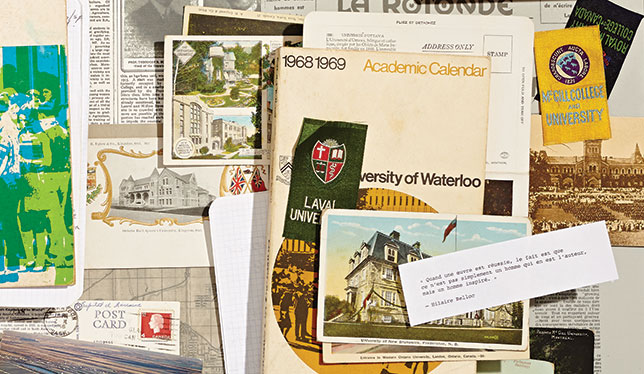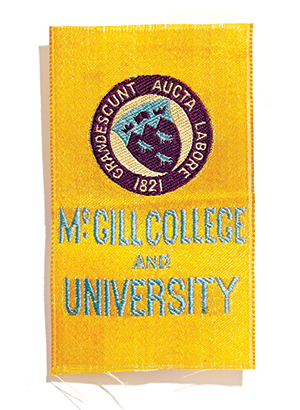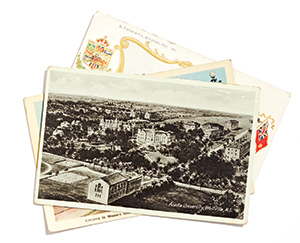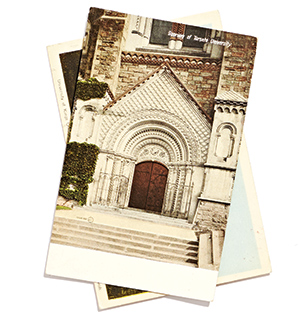On 2 May 2007, a group of about 30 people gathered for the dedication of ‘First Tree Plaza,’ a small stony square between UBC’s Old Auditorium and the Geography Building.” With this sentence begins UBC: The First 100 Years, a history of the University of British Columbia published in 2009. Readers learn that each year a graduating class plants a tree along a line of trees – among them a linden planted by the Class of 1909, a year after UBC was founded – in this corner of the campus. As co-author Eric Damer writes, it’s a “link to the rich and complex history of a great institution, its people, its traditions and its legacy.”
At 352 pages, UBC: The First 100 Years, straddles a middle ground between the two main types of university histories: those that are ambitious and scholarly, and those that are safe, self-congratulatory exercises in promotion. Yes, it’s a handsome, coffee table-style book which includes many archival photos and sidebars celebrating notable UBC figures. But it also touches on the prejudices facing Chinese, Japanese, East Indian and Aboriginal students in the early part of the 20th century; UBC’s unflattering reputation during the Depression years for being a “loafing place for rich men’s sons”; and, three decades later, undergrad protests over the “corporatization” of the university.
The UBC history has an unusual genesis. Herbert Rosengarten, a veteran academic then working in the president’s office, thought an institutional history should be written for the 100th anniversary in 2008. Three senior scholars were on the short list but gradually each one dropped out. The task was therefore bestowed on Dr. Damer, a sessional instructor with a PhD in educational studies from UBC who’d been hired by Dr. Rosengarten as a research associate on the project.
“It was a blessing that it wasn’t an officially sanctioned history,” says Dr. Damer. “I was never micro-managed by a committee; I just reported to Herbert. Still, I knew what’s expected of a book like this. If I made it a muck-raking history it might have ended up on a hard drive never to be seen again.”
Unlike Dr. Damer’s experience, most histories are commissioned by university administrations, usually to celebrate an anniversary or other milestone, and traditionally were taken on by historians late in their careers, when their reputations are established and the idea of looking back on their university appeals to them. “For an academic,” says York University faculty of education professor Paul Axelrod, an authority on the history of higher education, “it comes down to where you want to spend your time. If you take on a university history, the returns aren’t as great as if you were working on your own scholarly projects. That’s why so often the writers are toward the end of their academic careers.”
And writing one can be a thankless task. There are always competing interests, ranging from colleagues who take issue with a writer’s approach – or take umbrage at not being included in the text – to senior administrators who see the book primarily as a feel-good fundraising tool and discourage addressing controversial issues. “Many are ornamental coffee table books not primarily commissioned for scholarly purposes,” says Dr. Axelrod, “but the best ones have serious historical value as well.”
While scholars point to the most distinguished examples – the University of Oxford’s magnificent nine-volume history, for example, or Richard Selleck’s The Shop: The University of Melbourne 1850-1939, both of which enjoyed generous funding and arm’s-length independence from their respective institutions – few contemporary examples come close to these. In Canada, the histories most often cited as being first-rate are P.B. Waite’s two-volume The Lives of Dalhousie University, John Reid’s Mount Allison University: A History to 1963, Charles Johnston’s two-volume McMaster University, Blair Neatby and Don McEown’s Creating Carleton: The Shaping of a University and Michiel Horn’s York University: The Way Must Be Tried.
Dr. Horn, a professor emeritus at York and a specialist in the history of academic freedom, speaking of his connection to the institution, says he was an “outsider-insider.” Although he’d taught at York for years, his post at its Glendon College campus meant he was a step removed from the mother ship that was York’s huge Keele campus. In 2001, then-president Lorna Marsden, who Dr. Horn knew from their undergrad years, suggested creating “both a scholarly history and a picture book.” She told him he would be fully independent, and be given time off from his teaching duties and a research assistant. All of the university’s resources and people were available to him.
Dr. Horn covered York’s triumphs and challenges, from the development of world-class professional programs to the awkward early years of the suburban Keele campus and a faculty revolution in 1972-73 that resulted in the resignation of the president. It’s a solid history that doubles as a handsome coffee table book illustrated by noted photographer Vincenzo Pietropaolo. “I’m happy with the historical side,” says Dr. Horn, “but I also tried to entertain people. It makes me think of the Hilaire Belloc quote: ‘When I am dead, I hope it may be said: His sins were scarlet but his books were read.’”
Sometimes, though, respected university histories fall below the radar, even within academe. Take, for example, the Histoire de l’Université de Moncton, published in 2013 to coincide with the university’s 50th anniversary. Maurice Basque and Marc Robichaud, respectively the scientific adviser and a historian at the New Brunswick university’s Institut d’études acadiennes, proposed to the administration a sweeping history, including the 19th and 20th century colleges that formed the backbone of higher education in the province before Université de Moncton was founded.
“The administration knew it could use such a book as part of its promotional strategies for fundraising and gifts,” says Dr. Basque. Dr. Robichaud, in a joint interview, adds: “But it’s not just a beautiful, ‘feel good’ book. We include a critical view of what was going on over the years with enough real history to interest scholars in the future.”
“It’s a new interpretation of the university,” continues Dr. Basque. “The founding president published a history in 1975, but he was a major player in all the events and the book reflected that. Time has passed. There are new readers today and room for a book by historians who are more objective.”
But unlike, say, the bilingual Laurentian University or the University of Ottawa, Moncton is a French institution. As well-executed as the book is, being published only in French reduces its impact in Canada’s English- speaking academic world.
One development in the 1960s and ’70s that influenced university histories was the rise of “social histories” that focus on the lives of ordinary people with special attention to gender, class, ethnic and racial groups and demographic patterns. “The new social history reinvented the history of education as an important scholarly field of historical inquiry,” says William Bruneau, professor emeritus in the department of educational studies at UBC, who believes this may be a golden age of university histories. Their success, he adds, today as ever, depends on who is commissioned to write them – a credible author or a safe choice? – and the constraints imposed on that person by the powers-that-be.
“Historians are trained to think a particular way,” he says. “Take a bunch of disparate, distinctive facts and various experiences, from soft to hard, and create from that a believable account of the actions of groups and individuals in the past. And by past, I mean both recent and distant.”
Often overlooked for their contribution to the field, says Dr. Bruneau, are unofficial memoirs which may contain valuable, unfiltered data. One example is Kenneth McNaught’s Conscience and History: A Memoir, with its blow-by-blow description of the 1958 academic freedom scandal involving Harry Crowe. Dr. Crowe was a history professor at United College (later the University of Winnipeg) who was fired by the administration, triggering 15 resignations, Dr. McNaught’s among them. Another example is the late John Saywell’s Someone to Teach Them: York and the Great University Explosion, 1960-1973, which details the student revolts of the late ’60s over the hiring of U.S. professors and York’s unruly presidential struggles in the early ’70s. Dr. Bruneau adds that even notable former students can provide useful material for scholars, as the late author Pierre Berton did describing his time at UBC in his memoir Starting Out: 1920-1947.
Stretching the boundaries of university histories even further, sometimes they’re not written by academics at all. D’Arcy Jenish, for 15 years a senior writer at Maclean’s before launching a freelance business in 2001, had grown up in Peterborough and attended Trent University for one year before transferring to the University of Western Ontario to do his BA in English. In 2011, he heard about Trent’s 50th anniversary, to be celebrated in 2014, and approached a senior alumni affairs officer. He learned that a subcommittee of the anniversary committee was planning a book, so Mr. Jenish wrote a proposal in which he emphasized his experience writing for a wide, popular audience, promising chapters that would cover everything from historical background to details on the lives of faculty members, students and alumni. Rather than a university press, the contract went to ECW Press, a Canadian-owned independent publisher that produces books ranging from fiction, poetry and memoirs to social history, science and pop culture.
The result, a readable coffee table book, rather prosaically titled Trent University: Celebrating 50 Years of Excellence. While it may not meet the exacting standards of serious scholars, it bears the stamp of an experienced journalist with a historical bent. Yes, it’s celebratory but Mr. Jenish was at least able to address rocky periods. “In its relatively brief history,” he writes, “Trent has had more than its share of faculty revolts, strikes, petitions to the board and calls (sometimes heeded) for the removal of the president, not to mention student uprisings, protests, demonstrations and occupations of executive offices.”
“I think it was a real advantage that the book wasn’t written by an insider, an academic,” says Colin Taylor, a professor of geography who served as dean of arts and science from 1997 to 2006 and helped create a school of education at Trent. “D’Arcy brought a dispassionate, objective eye to the history. While it’s fair and balanced, he didn’t shy away from controversial aspects. It is a warts-and-all history.”
University presidents may be among the most eager readers of histories. As incoming president of Dalhousie in 1995, Tom Traves, a newcomer to Nova Scotia, remembers reading P. B. Waite’s The Lives of Dalhousie. In the first volume, Dr. Traves discovered the ways in which religion profoundly shaped the formation of Nova Scotia’s universities. Despite rivalries amongst religious-based universities carrying over into the publicly financed secular age, he learned that collaboration transcended individuals and issues, a useful insight that helped him understand the politics and mores of the province’s higher education politics.
Dr. Waite also provided him with the manuscript for volume two, because the book was more than a year away from being published. In it, “[he] reviewed the challenges of building a modern university as enrolments grew, institutions gained, and sometimes lost, public financial support, and developed their modern organizational forms,” says Dr. Traves. “As a new president, I was fascinated by the tensions that my predecessors faced and I certainly learned from the strategies they pursued with both happy and unhappy results.”
University fortunes, like their histories, wax and wane. The current era, it could be argued – marked by financial constraints, high expectations and constant change – is not an easy time for Canadian universities. Whether written by eminent scholars, young academics or outsiders, it’s a period when histories that place universities in a broad socio-economic and cultural context can help the postsecondary sector understand itself. And individual university histories will be there to help future scholars who may take on even more comprehensive projects.
David Turpin, president-elect of the University of Alberta and past president of the University of Victoria, commissioned a history for the 50th anniversary of UVic (Reaching Outward and Upward: The University of Victoria, 1963-2013). Written by a leading scholar, the late Ian MacPherson, it was a hybrid, like so many are today: a coffee table book that provided what Dr. Turpin describes as “a good, but not in-depth, historical outline of the institution.”
But Dr. Turpin believes another kind of history would be even more valuable. “There are so many factors at play today, so many challenges,” he says, “and it’s important to understand where you came from as well as where you’re going. So there is a need for a really scholarly overview that looks at all Canadian universities, the entire sector. Every history that’s been written will serve an important role if someone eventually takes that on.”




There is a place in University histories for an understanding of how individual faculties developed in the wider context of their disciplines. I have tried to do this for the business school at the University of Montreal: http://historicalstudiesineducation.ca/index.php/edu_hse-rhe/article/view/4312/4509.
D. McKeagan